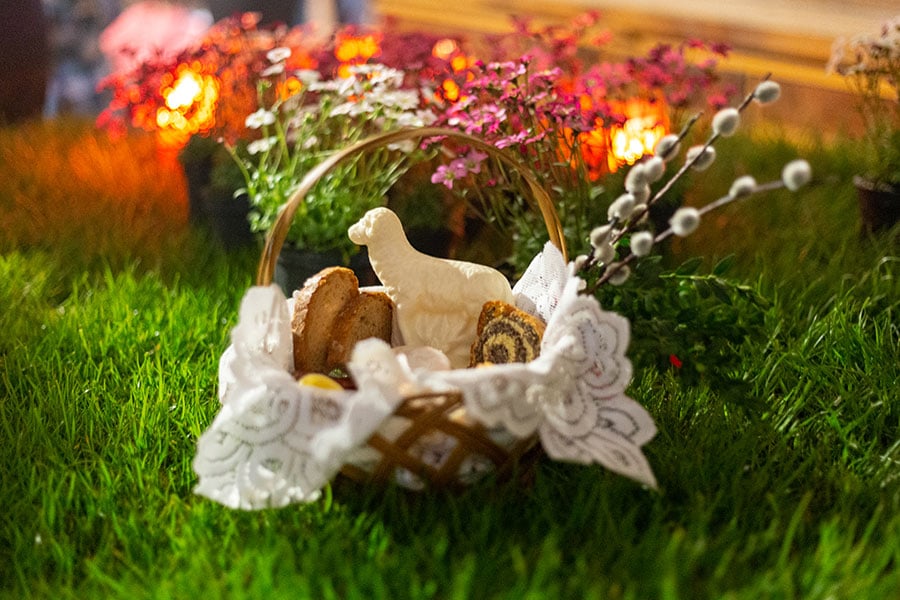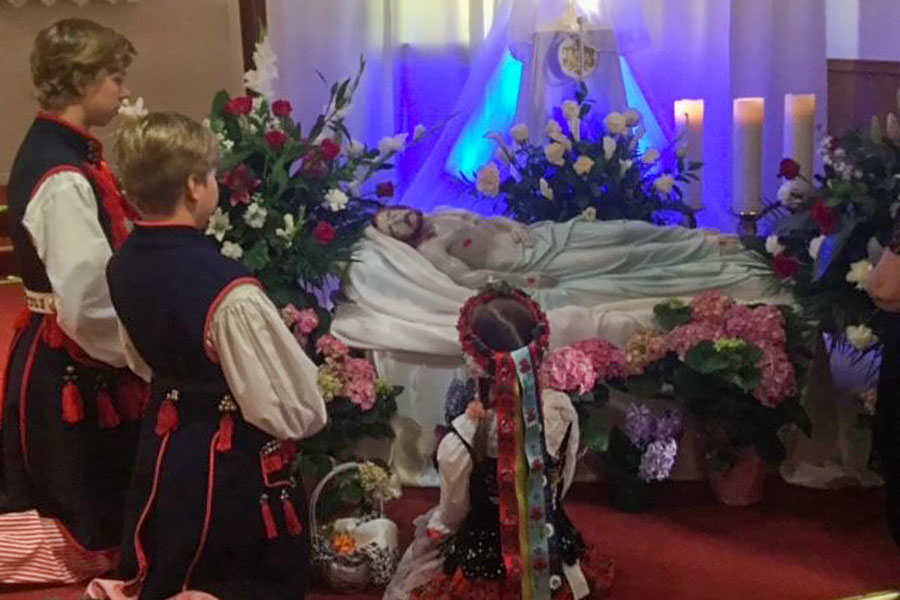Baskets, eggs, but no Easter bunny? Local Catholics share religious traditions of Easter in Poland

In Poland, families fill the Easter basket with foods for Easter breakfast, including eggs, bread, butter molded into a lamb, sausages, and more.
If there’s one time of the year when Maggie Harrison misses her homeland, it’s Easter.
Growing up outside of Warsaw, she remembers Holy Week leading up to the 6 a.m. Resurrection Mass as a time of church visits, prayer, and fasting.
“There was no Easter bunny or hiding chocolate,” explained the president of Cassata Catholic High School. “It was very religious and aspects of it were very somber.”
Even when the Communist party ruled the country, Easter remained a widely observed holiday full of religious traditions ingrained in every Pole.
All schools — even the public ones — closed during the Triduum.
“And the majority of us attended church on Holy Thursday, Good Friday, and Saturday,” said Harrison, whose Polish surname is Gruszczynska.
Polish Catholics would fast and abstain from meat until the parish blessing of the Easter baskets on Holy Saturday. For many families, Holy Saturday was also spent visiting various churches in town to pray and see representations of Jesus lying in the tomb.
These tableaus, called Grob Panski or Bozy Grob (Grave of the Lord), were designed to be religiously evocative, with a life-size figure of Christ, candles, flowers, angels, and three crosses.
“Some of the displays were extremely artistic and elaborate but not in a gaudy, inappropriate sense,” Harrison added. “It was a time for prayer and reflection, and I miss that.”
On Easter morning, the sound of church bells ringing filled the cities and countryside. Rising before dawn to attend the Resurrection Mass is a ritual as popular for Poles as worshipping at Christmas midnight Mass, Harrison suggested. Before the liturgy starts, the priest carries the Blessed Sacrament around the church three times as the altar servers ring handbells.

Returning home after Mass, families enjoy Swieconka, the breakfast meal that was blessed on Holy Saturday by a priest.
Filling the Easter basket with food for Swieconka is one of the most enduring and loved Polish customs, said the high school administrator. What people put in the basket, and how it’s decorated, varies from region to region and village to village.
“Every family has a special cloth — usually embroidered — that’s put on the bottom of the basket,” Harrison said. “Pisanki — colored eggs — are part of the tradition. How they are decorated depends on what part of the country you’re from.”
Crafted with treated wax, colored paper, and other techniques, the eggs feature flowers, crosses, and other elements of Easter. They symbolize hope, new life, and resurrection. Other foods included in the basket are butter molded into a lamb or a cross to celebrate the richness of salvation; Easter bread (babka) made of rich dough and raisins to remind us of Jesus, the Risen Lord; links of sausage representing the chains of death broken when Jesus rose from the dead; ham, a sign of great joy and abundance; and salt symbolizing preservation.
Some families also place horseradish in the basket, recalling the bitterness of the Passion, and a candle — the only non-edible item — to honor Jesus, the Light of the World.
During breakfast, relatives break off a piece of bread or egg and wish each other “Wesolego Alleluja!” meaning “Joyful Alleluia!”
“Part of a family’s tradition is what they put in the basket and how they decorate it,” says Olga Kraszewska, co-owner of European in Texas, a cafe and market offering Polish cuisine and products from Eastern European countries.
Polish immigrants and Americans of Polish heritage visit the Southlake store to buy sausage, lamb butters, and other goods for their Easter celebration. Some customers call the business hoping to find ready-made Swieconka baskets.
“We thought that was strange because putting it together is part of the fun,” the shop owner added. “You make it your own.”
Festooned with colorful ribbons, dried flowers, or sprigs of greenery (a sign of spring and new life), “some baskets are so ornate, they’re put on the table as a decoration on Easter Sunday.”
Kraszewska, a native of Poznan, Poland, didn’t realize the different ways people decorated eggs, baskets, and traditional foods until she moved away.
“But I noticed it here,” she continued. “In the U.S. we decorate eggs all different colors but my customers from Romania would only ask for red dye because, they told me, Christ’s blood was red. Every place has its own traditions.”
When her children were younger, they would complain about going to church on Holy Saturday for the blessing of the Easter baskets. Now they plan to carry on the custom with their own offspring.
“For those that came from Poland directly it’s a way of staying Polish even for the first and second generation of families,” Kraszewska explained. “It’s a way of saying we’re proud of who we are.”
After disappearing from the map of Europe for 123 years until it was restored as a nation in 1918, Poland had Catholic cloisters and monasteries to thank for preserving its language, culture, and faith, according to Harrison.
“We were first and foremost Catholic and then we were Poles,” said the educator. “Your religion and nationality went hand in hand. That’s why our Easter customs are still so important to us.”
Note: St. Peter Church, 2907 Woodall Rodgers Frwy. in Dallas, will bless Easter baskets every hour from 10 a.m. to 1 p.m. on Holy Saturday, April 8.
